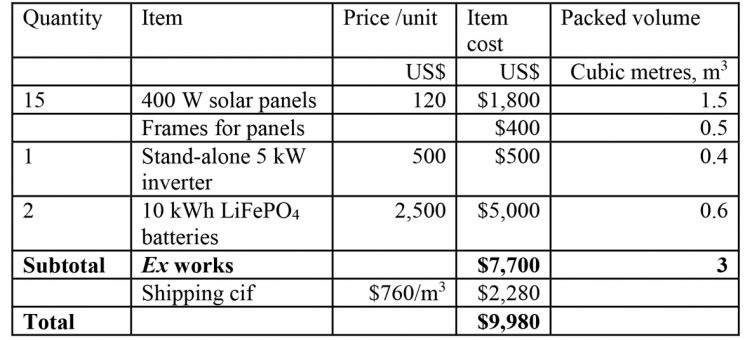Dear Editor,
I see Vice-President Dr Bharrat Jagdeo has thrown out a challenge for a company to produce solar power for the grid at 5 US cents per kilowatt hour (kWh). He will win. He is correct that large-scale batteries are not available to Guyana. Only countries like India and China who have the technology, raw materials, manufacturing, and management capacity can bring the price of solar down to 2 US cents per kWh when providing power of the order of 300 MW. But that was not my recommendation for little Guyana. I have plainly written my proposals in the public domain that emphasize the principle of the gear and gradual rollout of household solar. See, e.g., https://www.stabroeknews.com/2021/11/01/features/in-the-diaspora/the-solar-alternative-for-guyana/.
I understand Dr Jagdeo’s argument that Gas to Energy (GtE) is to tide us over the 20 years while alternative energy to fossil fuel becomes cheaper; and that the Government is already rolling out solar power. The insufficiencies of the latter will warrant separate treatment. I just want at this point to credit Dr Jagdeo for getting right what the Guyana Energy Agency (GEA) should have said (they were afforded the invoices to see exactly what the price of solar power installation was) and to discourage him from the GtE.
Let me give some 2023 figures for the systems I am recommending, so that those who will, can test my conclusions. It was not intended for the grid, but for households. Here is a current price estimate from Original Equipment Manufacturers (OEM) in China for anyone who wishes to check. (OEM can be contracted to put on brands for resellers all over the world). Businesses will see that containers will cut down shipping costs considerably.
Current use of sunlight is 200 W/m2, and the 30 m2 for the 15 panels can fit on most roofs. If the sun shines 5 hours in the day their 6 kW can generate 6 kW x 5 h = 30 kWh (kilowatt hours or units of electricity) per day. The stand-alone 5 kW inverter cannot be tied to the grid. It can be used to power an average household (with inductance for fridge, washing machine, microwave, pump, and fans). Its pure sine wave is safe for computers and sensitive equipment and will keep such equipment from damage during unreliable grid power. The hybrid inverter for automatic changeover from grid to battery could be more than 3 times the price. Why not do it manually by just using a suitably dimensioned changeover switch? And where there is no electricity, a hybrid system is not required. The batteries can store up to 20 kWh of the energy that is not used in the day. So if 10 kWh is used in a day, then there can be 20 kWh available for 2 rainy days; and even on rainy days the panels still collect some electricity during daylight.
For DIY enthusiasts with properly wired homes, this can cost as little as US$10,000. For 5 000 W of inverter and 6 000 W of panels this works out to less than US$2 per installed watt. In India and China this would be less than US$1.4 per installed watt. For comparison, current disclosed costs of the GtE project are about US$2,100,000,000 for 300 000 000 W, or US$7 per installed watt. Bear in mind that electricity transmission and distribution (T&D), management and operation costs are yet to be disclosed for GtE, the costs for which keep rising; whereas all this is negligible for isolated household solar power systems, the costs for which keep falling.
The solar panels are usually guaranteed to lose no more than 20% by 25 years of use. The inverters can now last 20 years, and the LiFePO4 batteries can now last 8 000 daily charge/discharge cycles or the equivalent of over 20 years. So, if 20 kWh is used daily for 20 years, it works out to 6.8 US cents/kWh. Getting professional help and more wiring should not take the cost to much more than 8 US cents/kWh. What are all the costs that will determine the GtE price per kWh?
As a pensioner who gets some part-time work, I cannot afford the US$10,000 for this kind of solar power. Instead, I use 0.56 kW of solar panels, a 40 A charge controller, 2 kW of pure sine wave inverter (to protect my sensitive electronics), a 2 kWh LiFePO4 battery, and switches to put the solar power to whichever parts of the house I want. With this kind of management, I cut down my electricity bill from $12,000 to $5,000 per month. But I can afford to give my figures to the Guyanese public. Why can’t the Government, funded by taxpayers, roll out decent systems that have a chance of getting useful things done? There will be no need for expensive capital or dependence on loans ― and therefore no need to hide the interest rates ― when it is rolled out as the oil money comes in.
I was impressed to hear a Maths & Science building was opened at UG on April 19 and more impressed to see enthusiastic students exhibiting at the Open Day on April 20. The Government is doing well here, but when these students come to realize that the data they should have from their own country, as befits a university, is made officially secret by their own government, our best young mathematicians and scientists will head to other countries where there are Open Data policies. Why not empower their human capital with better solar power systems, beginning in the areas where there is no electricity? Innovative ways exist to distribute fairly and to incentivise as the oil money comes in. Solar power can be offered in a socially homogeneous area to households whose children attend school or attain some educational standard.
Yours faithfully,
Alfred Bhulai






